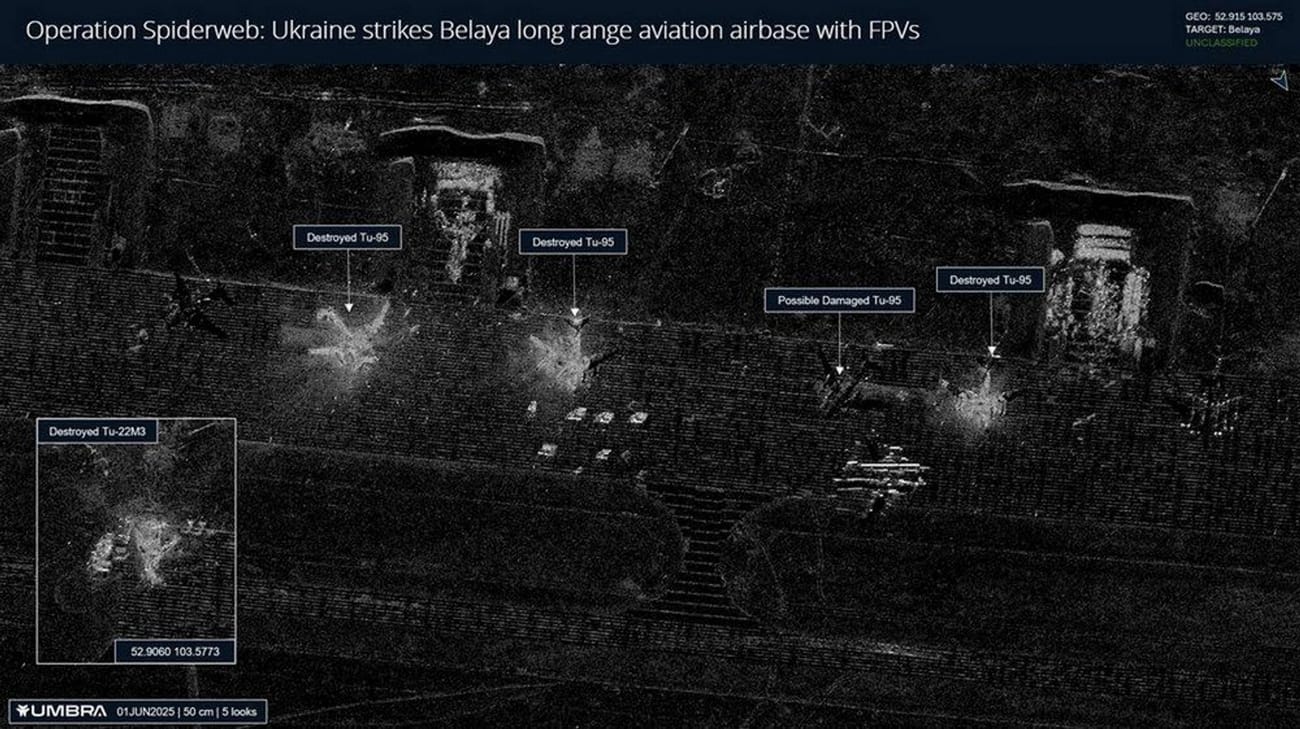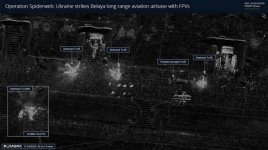Fuck Off.....failure at life.Sleep it off, chucklehead.
You are using an out of date browser. It may not display this or other websites correctly.
You should upgrade or use an alternative browser.
You should upgrade or use an alternative browser.
Map of Russia's special operations in Ukraine, the advance of Russian troops, militar
- Thread starter roman olkhovsky
- Start date
roman olkhovsky
Verified User
Footage of an attempt by a Ukrainian mechanized group to break through from the Sumy region of Ukraine to the Kursk region of Russia. The composition of the Ukrainian group - ATVs, infantry fighting vehicles and armored personnel carriers - could not be determined. Russian artillery and drones were used against the Ukrainian group. The video is shortened, showing active moments of the battle
View: https://www.youtube.com/watch?v=pQHDJ2cASUo
roman olkhovsky
Verified User
Footage of a Russian Kh-38 missile hitting a Ukrainian bridge. The location of the shooting is unknown, it was previously reported that Ukrainian units were stationed near the bridge. The Kh-38 air-to-surface missile was presumably launched by a Russian Su-34 fighter-bomber. Technical information about the Kh-38 missile is in the link to the video in the comments to the video.
View: https://www.youtube.com/watch?v=75XXgN8X3Uc
roman olkhovsky
Verified User
Unique footage of an air battle between two drones in Ukraine. In the video, a Russian DJI Mavic drone cuts the fiber optic cable of a Ukrainian FPV drone with its propellers. As a result of losing contact with the operator, the Ukrainian drone falls.
View: https://www.youtube.com/watch?v=PMlUXRxpCcc
moon
Satire for Sanity
Fibre-optic drones

 www.bbc.co.uk
www.bbc.co.uk

Fibre optic drones: The terrifying new weapon changing the war in Ukraine
The BBC reports from Donetsk where swarms of fibre optic drones give Russia the edge as Ukraine defends towns behind the front line.
moon
Satire for Sanity
^Total dumbass heard from ^Who’s winning, Roman?
roman olkhovsky
Verified User
The first footage of a Russian kamikaze drone "Lancet-51" striking a Ukrainian checkpoint. This has not been observed before, usually "Lancet" drones only attack military equipment. The video was filmed near the village of Glybnoe in the Sumy region of Ukraine.
View: https://www.youtube.com/watch?v=8PQW1zZ8XOs
roman olkhovsky
Verified User
Footage of a Russian, presumably Iskander-M ballistic missile striking Ukrainian long-range kamikaze UAV launch sites. The video was filmed near the airfield of the city of Chuguev, Kharkov region of Ukraine.
Judging by the video, the Iskander-M missile hit the center of the Ukrainian UAV launch sites.
View: https://www.youtube.com/watch?v=GTS4vZtWmCQ
Judging by the video, the Iskander-M missile hit the center of the Ukrainian UAV launch sites.
roman olkhovsky
Verified User
Ukrainian media published footage of Ukrainian FPV drone strikes on the Belaya airbase in the Irkutsk region of Russia. Russian Tu-95 bombers were stationed at the Belaya airbase. According to eyewitnesses, a truck pulled up to a gas station, FPV drones started taking off from it, the driver of one of the trucks was found dead. It is worth noting that such an FPV attack cannot be repelled. Due to the fact that no air defense can shoot down FPV drones now. Also, such an attack was not expected in the rear, a well-trained sabotage group was working. It is possible that the group includes Russian residents, it is also possible that the truck contains equipment for remote launch and control of FPV drones. Judging by the video, as a result of the attack, 4 Tu-95 bombers were damaged, most likely destroyed. The Russian Olenya airbase in the Murmansk region was also attacked. The base reportedly had air defense, including the Pantsir air defense missile system, but it cannot hit FPV drones. Eyewitnesses counted 11 FPV drones.
View: https://www.youtube.com/watch?v=qrnLFvysi0M
How about this one, Roman?

 www.pravda.com.ua
www.pravda.com.ua

First satellite images of destroyed Russian aircraft at Belaya airbase appear online

First satellite images of destroyed Russian aircraft at Belaya airbase appear online
The first satellite images have appeared online, allowing for a better assessment of Russian losses at the Belaya airbase in Irkutsk Oblast during a special operation by the Ukrainian Security Service.

roman olkhovsky
Verified User
Details of the Ukrainian operation Spider Web, an attack by FPV drones on Russian military airfields, have become known. The operation was prepared for 1.5 years, it was planned to attack the airfields "Belaya" - Irkutsk region, "Olenya" - Murmansk region, "Ukrainka" - Amur region, "Dyagilevo" - Ryazan region, "Ivanovo" - Ivanovo region. As a result, 2 airfields were attacked, "Belaya" - Irkutsk region and "Olenya" - Murmansk region. It is worth noting that the operation was truly large-scale. To carry out the operation, a warehouse was rented in Chelyabinsk, hundreds of FPV drones were delivered there, and later "mobile wooden houses". It is possible that the FPV drones were assembled on site. These houses were placed on trucks, and FPV drones were hidden under their roofs. The wooden structures were designed in such a way that their upper part could be opened remotely. From this warehouse, trucks were then sent to other cities, one of the truck drivers was later found dead. The drones were controlled on non-standard frequencies, so electronic warfare had no effect on them. Presumably, cellular communications were used to communicate with the drones, some sources reported on Starlink terminals located in the forests. Trucks with containers stopped on roads and parking lots, after which drones took off from there. One truck was blocked by drivers in the parking lot, in the video people throw stones at the top of the container with drones, it is worth noting that there is a police car nearby. It can be said that thanks to the drivers, many planes were saved. Several containers caught fire and exploded on the highway on the way to the airfields, presumably the drones overheated in the containers. The video shows a truck in the Amur Region, if it and other trucks had arrived, there would have been more destroyed planes. How this could have been prevented, first of all, this is the work of the special services, but they are now overloaded with identifying sabotage and terrorist attacks. It would be possible to reduce losses if the aircraft were placed in hangars, they have been talking about them for 3 years, but so far only projects have been shown. Also, we need anti-FPV groups. Cellular communications, including "Starlink", should be jammed at airfields. Electronic warfare and air defense systems are already present at some airfields, but no one expected threats from FPV. Also, we need anti-FPV groups now. It is worth noting that no air defense systems or air defense systems in the world can confidently hit FPV drones. Satellite images have already confirmed the destruction of three Tu-95MS and damage to one aircraft at the Belaya airfield, and four Tu-22M3s were destroyed. We also saw a burning An-12 on video, but it is not in the pictures. There is no video about the Olenya airfield, the SBU of Ukraine did not show anything, but there was a fire there. Thus, the loss of 40 aircraft is not confirmed at the moment, but videos may appear later. It turned out to be a fake that the drones had artificial intelligence, and in the video they were controlled by operators.
View: https://www.youtube.com/watch?v=xonNFoDdu1M
roman olkhovsky
Verified User
Unique footage of the alleged hijacking of a Ukrainian LAV Super Bison armored personnel carrier by a Russian sabotage group. The location of the shooting is not reported. In the video, you can see a Ukrainian driver-mechanic running behind the armored personnel carrier, but he cannot catch up with it. It is possible that the Ukrainian servicemen simply forgot their comrade. We have previously published a video of the hijacking of a Ukrainian tank from the battlefield. LAV Super Bison armored personnel carriers have been produced in Canada since 2020
View: https://www.youtube.com/watch?v=S-006ac3o5g
roman olkhovsky
Verified User
An episode of combat use in Ukraine, the Russian helicopter Ka-52. In the video, the Ka-52 helicopter fires from a 30-mm 2A42 cannon at a Ukrainian drone. The location of the shooting is not reported, the model of the Ukrainian drone is unknown.
View: https://www.youtube.com/watch?v=jn6Us-tst5M
roman olkhovsky
Verified User
Footage of the strike of the Russian Iskander-M ballistic missile, 9M723-K5 with a cluster warhead, on the Ukrainian military training ground Novomoskovsky, near the settlement of Gvardeyskoye in the Dnipropetrovsk region of Ukraine. It is worth noting that this is the second strike on this training ground. The training ground housed a tent camp of the 158th and 33rd brigades of the Armed Forces of Ukraine. As a result of the Iskander-M missile strike, about 75 servicemen were killed, the Ukrainian army reported 12 fatalities, and the commander of the Ground Forces of Ukraine, Mykhailo Drapatiy, decided to resign.
View: https://www.youtube.com/watch?v=Txqex_XAb7U
roman olkhovsky
Verified User
The SBU of Ukraine published footage of the explosion of one of the supports of the Crimean Bridge. According to the SBU, the bridge support was mined with 1,100 kg of explosives in TNT equivalent. It is worth noting that the explosion does not look like the use of explosives of such power. It is more likely that the Ukrainian underwater kamikaze drone "Marichka" or underwater drone Toloka was used, it is controlled by Starlink. Earlier, Ukraine tested new underwater drones "Marichka", technical information about them is in the link to the video in the comments to the video. Now the bridge is operating normally.
View: https://www.youtube.com/watch?v=VsbjKSNKQ2c
roman olkhovsky
Verified User
Footage of the strike of the Russian kamikaze drone "Lancet-51" on the Ukrainian naval drone Magura V7, armed with two anti-aircraft missiles AIM-9 "Sidewinder". The video was filmed near the Crimean Bridge, the Ukrainian naval drone tried to attack the bridge. This is the second attempt to attack the bridge in a day. As a result of the strike of the drone "Lancet-51", the Ukrainian naval drone was destroyed. It is worth noting that if the drone was near the bridge, then "Starlink" is not jammed there, which is a significant vulnerability.
View: https://www.youtube.com/watch?v=EOLdQN-yCCo
roman olkhovsky
Verified User
Footage of a strike by a Russian Iskander-M ballistic missile on the Ukrainian IRIS-T SLM air defense missile system. The video was filmed near the village of Zarechnoye, Dnipropetrovsk Oblast, Ukraine. The strike was carried out on the most important component of the air defense system, the TRML-4D radar. The TRML-4D radar is produced in Germany and is considered one of the most advanced. An Iskander-M air-burst missile was used for the strike.
View: https://www.youtube.com/watch?v=aH4LGL83dd4
roman olkhovsky
Verified User
Footage of a Russian Iskander missile with a cluster warhead hitting the positions of Ukrainian long-range drone operators. It is worth noting that visually it looks more like the use of Tornado-S missiles. The video was filmed at an airfield near the city of Krolevets in the Sumy region of Ukraine. Judging by the video, one submunition exploded directly above the drone operators.
View: https://www.youtube.com/watch?v=6cqMx-Mveu0
